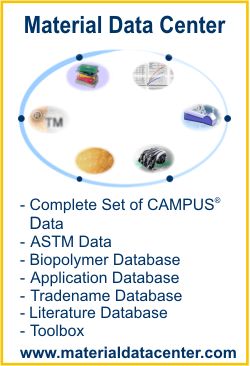Material Data Center is a leading international information system for the plastics industry. Material Data Center offers a comprehensive plastics database, calculation tools, CAE interfaces, a literature database and an application database. For more information about Material Data Center visit www.materialdatacenter.com.
This is the free Material Data Center Datasheet of CELANEX® 2300 GV3/20 - PBT-GB20 - Celanese
unit conversion, PDF datasheet print, comparison with other plastics, snap fit calculation, beam deflection calculation, parameters for material models, CAE Interfaces
Check here, which other Celanex datasheets, application examples or technical articles are available in Material Data Center
| Flammability @1.6mm nom. thickn. | HB | - |
| Flammability at thickness h (0.82 mm) | HB | UL recognition (h) |
| Processing/Physical Characteristics | Value | Unit | Test Standard | ||||||||||||||||||||||||||||||||||||||||||||||||||||||||||||||||||||||||||||||||||||||||||||||||
| ISO Data | |||||||||||||||||||||||||||||||||||||||||||||||||||||||||||||||||||||||||||||||||||||||||||||||||||
| Melt volume-flow rate, MVR | 20 | cm³/10min | ISO 1133 | ||||||||||||||||||||||||||||||||||||||||||||||||||||||||||||||||||||||||||||||||||||||||||||||||
| Temperature | 250 | °C | - | ||||||||||||||||||||||||||||||||||||||||||||||||||||||||||||||||||||||||||||||||||||||||||||||||
| Load | 2.16 | kg | - | ||||||||||||||||||||||||||||||||||||||||||||||||||||||||||||||||||||||||||||||||||||||||||||||||
| Molding shrinkage, parallel | 1.8 | % | ISO 294-4, 2577 | ||||||||||||||||||||||||||||||||||||||||||||||||||||||||||||||||||||||||||||||||||||||||||||||||
| Molding shrinkage, normal | 1.6 | % | ISO 294-4, 2577 | ||||||||||||||||||||||||||||||||||||||||||||||||||||||||||||||||||||||||||||||||||||||||||||||||
| Mechanical properties | Value | Unit | Test Standard | ||||||||||||||||||||||||||||||||||||||||||||||||||||||||||||||||||||||||||||||||||||||||||||||||
| ISO Data | |||||||||||||||||||||||||||||||||||||||||||||||||||||||||||||||||||||||||||||||||||||||||||||||||||
| Tensile Modulus | 3500 | MPa | ISO 527 | ||||||||||||||||||||||||||||||||||||||||||||||||||||||||||||||||||||||||||||||||||||||||||||||||
| Stress at break | 50 | MPa | ISO 527 | ||||||||||||||||||||||||||||||||||||||||||||||||||||||||||||||||||||||||||||||||||||||||||||||||
| Strain at break | 4 | % | ISO 527 | ||||||||||||||||||||||||||||||||||||||||||||||||||||||||||||||||||||||||||||||||||||||||||||||||
| Charpy impact strength, +23°C | 34 | kJ/m² | ISO 179/1eU | ||||||||||||||||||||||||||||||||||||||||||||||||||||||||||||||||||||||||||||||||||||||||||||||||
| Charpy impact strength, -30°C | 34 | kJ/m² | ISO 179/1eU | ||||||||||||||||||||||||||||||||||||||||||||||||||||||||||||||||||||||||||||||||||||||||||||||||
| Charpy notched impact strength, +23°C | 3.5 | kJ/m² | ISO 179/1eA | ||||||||||||||||||||||||||||||||||||||||||||||||||||||||||||||||||||||||||||||||||||||||||||||||
| Charpy notched impact strength, -30°C | 3.5 | kJ/m² | ISO 179/1eA | ||||||||||||||||||||||||||||||||||||||||||||||||||||||||||||||||||||||||||||||||||||||||||||||||
| Thermal properties | Value | Unit | Test Standard | ||||||||||||||||||||||||||||||||||||||||||||||||||||||||||||||||||||||||||||||||||||||||||||||||
| ISO Data | |||||||||||||||||||||||||||||||||||||||||||||||||||||||||||||||||||||||||||||||||||||||||||||||||||
| Melting temperature, 10°C/min | 225 | °C | ISO 11357-1/-3 | ||||||||||||||||||||||||||||||||||||||||||||||||||||||||||||||||||||||||||||||||||||||||||||||||
| Temp. of deflection under load, 1.80 MPa | 70 | °C | ISO 75-1/-2 | ||||||||||||||||||||||||||||||||||||||||||||||||||||||||||||||||||||||||||||||||||||||||||||||||
| Temp. of deflection under load, 0.45 MPa | 180 | °C | ISO 75-1/-2 | ||||||||||||||||||||||||||||||||||||||||||||||||||||||||||||||||||||||||||||||||||||||||||||||||
| Vicat softening temperature, B | 190 | °C | ISO 306 | ||||||||||||||||||||||||||||||||||||||||||||||||||||||||||||||||||||||||||||||||||||||||||||||||
| Coeff. of linear therm. expansion, parallel | 110 | E-6/K | ISO 11359-1/-2 | ||||||||||||||||||||||||||||||||||||||||||||||||||||||||||||||||||||||||||||||||||||||||||||||||
| Burning Behav. at 1.5 mm nom. thickn. | HB | class | IEC 60695-11-10 | ||||||||||||||||||||||||||||||||||||||||||||||||||||||||||||||||||||||||||||||||||||||||||||||||
| Thickness tested | 1.6 | mm | - | ||||||||||||||||||||||||||||||||||||||||||||||||||||||||||||||||||||||||||||||||||||||||||||||||
| Burning Behav. at thickness h | HB | class | IEC 60695-11-10 | ||||||||||||||||||||||||||||||||||||||||||||||||||||||||||||||||||||||||||||||||||||||||||||||||
| Thickness tested | 0.8 | mm | - | ||||||||||||||||||||||||||||||||||||||||||||||||||||||||||||||||||||||||||||||||||||||||||||||||
| Yellow Card available | yes | - | - | ||||||||||||||||||||||||||||||||||||||||||||||||||||||||||||||||||||||||||||||||||||||||||||||||
| Oxygen index | 21 | % | ISO 4589-1/-2 | ||||||||||||||||||||||||||||||||||||||||||||||||||||||||||||||||||||||||||||||||||||||||||||||||
| Electrical properties | Value | Unit | Test Standard | ||||||||||||||||||||||||||||||||||||||||||||||||||||||||||||||||||||||||||||||||||||||||||||||||
| ISO Data | |||||||||||||||||||||||||||||||||||||||||||||||||||||||||||||||||||||||||||||||||||||||||||||||||||
| Relative permittivity, 100Hz | 4.4 | - | IEC 62631-2-1 | ||||||||||||||||||||||||||||||||||||||||||||||||||||||||||||||||||||||||||||||||||||||||||||||||
| Relative permittivity, 1MHz | 4.2 | - | IEC 62631-2-1 | ||||||||||||||||||||||||||||||||||||||||||||||||||||||||||||||||||||||||||||||||||||||||||||||||
| Dissipation factor, 100Hz | 85 | E-4 | IEC 62631-2-1 | ||||||||||||||||||||||||||||||||||||||||||||||||||||||||||||||||||||||||||||||||||||||||||||||||
| Dissipation factor, 1MHz | 180 | E-4 | IEC 62631-2-1 | ||||||||||||||||||||||||||||||||||||||||||||||||||||||||||||||||||||||||||||||||||||||||||||||||
| Volume resistivity | >1E13 | Ohm*m | IEC 62631-3-1 | ||||||||||||||||||||||||||||||||||||||||||||||||||||||||||||||||||||||||||||||||||||||||||||||||
| Surface resistivity | >1E15 | Ohm | IEC 62631-3-2 | ||||||||||||||||||||||||||||||||||||||||||||||||||||||||||||||||||||||||||||||||||||||||||||||||
| Electric strength | 26 | kV/mm | IEC 60243-1 | ||||||||||||||||||||||||||||||||||||||||||||||||||||||||||||||||||||||||||||||||||||||||||||||||
| Other properties | Value | Unit | Test Standard |
| Water absorption | 0.45 | % | Sim. to ISO 62 |
| Humidity absorption | 0.2 | % | Sim. to ISO 62 |
| Density | 1450 | kg/m³ | ISO 1183 |
The time between drying and processing should be kept as short as possible. The processing machine feed hopper should be closed during the processing operation.
Melt Temperature 260-270 °C
Mold Temperature *) 75-85 °C
Maximum Barrel Residence Time **) 5-10 min
Injection Speed fast
Peripheral screw speed max.0,3 m/sec
Back Pressure 10-30 bar
Injection Pressure 600-1000 bar
Holding Pressure 400-800 bar
Nozzle Design open design preferred
Injection speed, injection pressure and holding pressure have to be optimized to the individual article geometry. To avoid material degradation during processing low back pressure and minimum screw speed have to be used. Overheating of the material has to be avoided. For grades containing flame retardants, a maximum temperature of 265 °C should not be exceeded.
Celanese recommends only externally heated hot runner systems.
*) For moulded parts with especially high requirements to the surface quality or dimensional stability, a mold temperature of up to 110 °C can be advantageous.
**) If the cylinder temperatures are higher than the recommended maximum temperatures, the max. residence time in the barrel has to be reduced.
Material Data Center is provided by M-Base Engineering + Software GmbH. M-Base Engineering + Software GmbH assumes no liability for the system to be free of errors. Any decision about the application of materials must be double checked with the producer of this material.
Additional information about this material, like producer contact address, etc. can be found at www.materialdatacenter.com. For access to this extra information a registration is requested. Free online registration is available.













